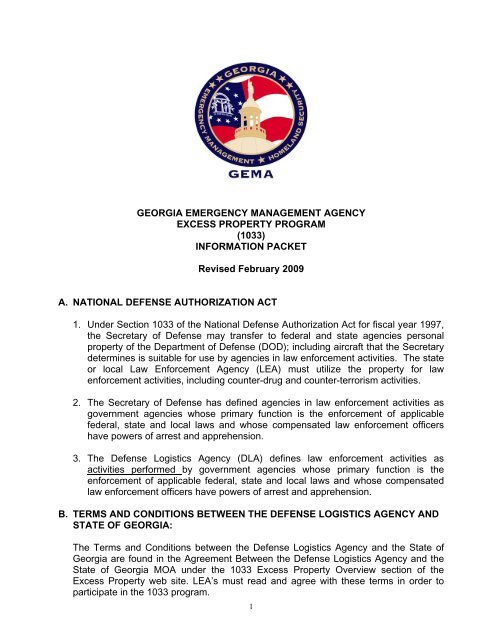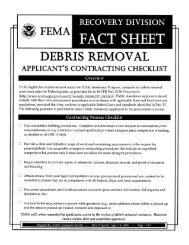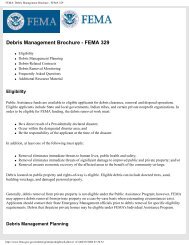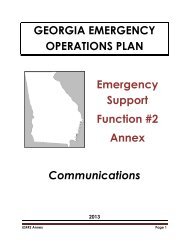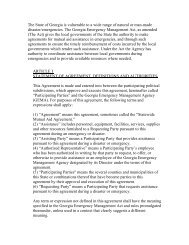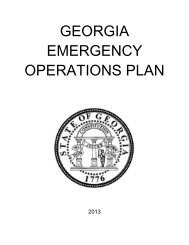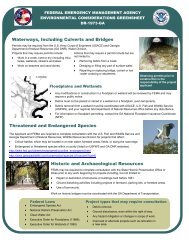EXCESS PROPERTY PROGRAM - GEMA/Homeland Security
EXCESS PROPERTY PROGRAM - GEMA/Homeland Security
EXCESS PROPERTY PROGRAM - GEMA/Homeland Security
Create successful ePaper yourself
Turn your PDF publications into a flip-book with our unique Google optimized e-Paper software.
GEORGIA EMERGENCY MANAGEMENT AGENCY<br />
<strong>EXCESS</strong> <strong>PROPERTY</strong> <strong>PROGRAM</strong><br />
(1033)<br />
INFORMATION PACKET<br />
Revised February 2009<br />
A. NATIONAL DEFENSE AUTHORIZATION ACT<br />
1. Under Section 1033 of the National Defense Authorization Act for fiscal year 1997,<br />
the Secretary of Defense may transfer to federal and state agencies personal<br />
property of the Department of Defense (DOD); including aircraft that the Secretary<br />
determines is suitable for use by agencies in law enforcement activities. The state<br />
or local Law Enforcement Agency (LEA) must utilize the property for law<br />
enforcement activities, including counter-drug and counter-terrorism activities.<br />
2. The Secretary of Defense has defined agencies in law enforcement activities as<br />
government agencies whose primary function is the enforcement of applicable<br />
federal, state and local laws and whose compensated law enforcement officers<br />
have powers of arrest and apprehension.<br />
3. The Defense Logistics Agency (DLA) defines law enforcement activities as<br />
activities performed by government agencies whose primary function is the<br />
enforcement of applicable federal, state and local laws and whose compensated<br />
law enforcement officers have powers of arrest and apprehension.<br />
B. TERMS AND CONDITIONS BETWEEN THE DEFENSE LOGISTICS AGENCY AND<br />
STATE OF GEORGIA:<br />
The Terms and Conditions between the Defense Logistics Agency and the State of<br />
Georgia are found in the Agreement Between the Defense Logistics Agency and the<br />
State of Georgia MOA under the 1033 Excess Property Overview section of the<br />
Excess Property web site. LEA’s must read and agree with these terms in order to<br />
participate in the 1033 program.<br />
1
C. ACCOUNTABILITY OF HIGH DOLLAR SENSITIVE ITEMS AFTER A DOMESTIC<br />
DISASTER:<br />
1. At the first available opportunity following a domestic disaster, LEAs will initiate a<br />
100 percent inventory check of high dollar sensitive items to include aircraft and<br />
weapons. Immediately upon completion of the inventory, LEAs must submit to the<br />
Excess Property Office a list and the status of the inventory. This report must be<br />
accomplished within 30 days after the domestic disaster has occurred. Failing to<br />
conduct a 100 percent inventory of the high dollar sensitive equipment and submit<br />
the inventory will risk suspension from the program to include turn-in or transfer of<br />
all equipment received through the 1208 & 1033 program.<br />
2. After a domestic disaster, the State Coordinator is responsible for collecting the<br />
inventory from each LEA that was affected by the domestic disaster. Once the SC<br />
receives the inventory, the SC must provide such notice in writing to the Law<br />
Enforcement Support Office, Fort Belvoir, VA.<br />
3. The Accountability Status Report (ASR) is found as a separate file on the<br />
Excess Property Website under the 1033 Excess Property – Sample Forms link.<br />
D. ADMINISTRATIVE SERVICE CHARGE:<br />
1. All 1033 property will have a 6% surcharge. This is an administrative fee, which is<br />
6% of the acquisition price on the DD Form 1348, for shipments over $500.00.<br />
Some items may have a cap to the surcharge fee. LEAs should check with the<br />
State Point of Contact (SPOC) regarding all surcharge fees.<br />
2. It is vital that LEAs send the DD Form 1348 and the Receivable Inventory List to<br />
the State Point of Contact (SPOC). Invoices must be paid within 30 days or the<br />
LEA will be prohibited from screening property until the account is paid in full. The<br />
DD Form 1348 will be provided by the DRMO at the location where the property is<br />
being received. The Receivable Inventory List is under the 1033 Excess Property -<br />
Overview section of the Excess Property web site.<br />
3. It is the LEA’s responsibility to request title for all vehicles to include trailers and<br />
any other items that require a title from the receiving DRMO. The Request for Title<br />
form is under the 1033 Excess Property Overview section of the Excess Property<br />
web site.<br />
E. REQUIREMENTS TO OBTAIN <strong>EXCESS</strong> DEPARTMENT OF DEFENSE (DOD)<br />
<strong>PROPERTY</strong> FOR LAW ENFORCEMENT AGENCIES (LEA) (Section 1033)<br />
As part of our ongoing efforts to make it simpler for LEA’s to get DOD property, the<br />
system has gone to an automated process. There are several web sites that LEA’s will<br />
need to properly utilize this service.<br />
2
1. The first web page is http://www.gema.ga.gov<br />
a. This is this is <strong>GEMA</strong> home page were there is a link to Excess Property. In<br />
order to participate in the program, you must have an updated LEA data<br />
sheet on file with the Excess Property Office. The LEA data sheet drives the<br />
process. Once this office receives the completed LEA data sheet, your<br />
department will be issued a login ID. The LEA data sheet must be updated<br />
whenever there are changes in the number of sworn officers, LEA POC’s,<br />
Weapon POC’s or when the head of the agency changes.<br />
2. The second web page is: https://pubweb.drms.dla.mil/cmis/default.asp<br />
a. This is the Law Enforcement Support Office (LESO) home page which has<br />
links to on-line training and the policy and procedures supporting the<br />
1208/1033 property disposal program.<br />
3. The third web page is http://www.drms.dla.mil/<br />
a. This is the Defense Reutilization and marketing Service (DRMS) web page<br />
which has the automated screening program for LEA’s to look for property.<br />
F. REQUEST FOR FIREARMS: (Firearms require a separate request.)<br />
1. On agency letterhead, the following questions must be answered in narrative form<br />
and separately.<br />
a. Name, Address, Phone and Fax numbers.<br />
b. Full name of the executive head.<br />
c. Any additional points of contact.<br />
d. Number of sworn officers to include reserve officers.<br />
e. Number of counter-drug officers.<br />
f. Number of counter-terrorism officers.<br />
g. Number of personnel assigned to a tactical team.<br />
2. The LEA must make a statement in their letter that the agency head has read and<br />
understands the terms and conditions applicable to weapons transfer as detailed in<br />
the Memorandum of Agreement between the Defense Logistics Agency and the<br />
State of Georgia (see section B). In addition, the following information must be<br />
included:<br />
a. The agency has the ability to maintain, operate, finance and properly store<br />
the requested weapons.<br />
b. The agency understands that all weapons must be registered with the<br />
Bureau of Alcohol, Tobacco and Firearms on BATF Form 10.<br />
c. The type and quantity of weapons being requested, its intended use and the<br />
impact the resource will have on the requesting agency’s jurisdiction and<br />
surrounding jurisdictions.<br />
d. The size of the requesting agency’s jurisdiction population.<br />
3
3. The total maximum of approved weapons cannot exceed 20 percent of the number<br />
of sworn officers. Previous transfer of like weapons through the 1208/1033<br />
Programs will also affect the number of weapons approved. The Excess Property<br />
SPOC is accountable for the ultimate disposition of all weapons issued. If a<br />
weapon becomes unserviceable, or is no longer required, the SPOC must be<br />
contacted as soon as possible. The SPOC will explain the actions to be taken to<br />
dispose of the property. Weapons cannot be sold or traded; these are DEMIL<br />
required items.<br />
4. Once LESO has notified the <strong>GEMA</strong> Excess Property Office of the transfer of the<br />
weapons, the LEA will be notified in order to proceed with the transfer of the<br />
requested weapons. The will involve someone from the requesting department to<br />
hand deliver to the <strong>GEMA</strong> Excess Property Office a certified or casher’s check,<br />
bank money order, or postal money order, payable to U.S. Treasury, in the<br />
specified. This covers all shipping charges. The LEA’s agency representative will<br />
sign a “Transfer Agreement” and will be given a copy for their records. This must<br />
be completed with 30 days of the notification. You will be invoiced separately<br />
for the surcharge.<br />
5. LEA’s must provide the <strong>GEMA</strong> Excess Property Office with a copy of the ATF<br />
Form 10, a copy showing that they have submitted the ATF Form 10 to ATF, and a<br />
copy of the approval from ATF showing that the weapons are registered with ATF.<br />
Blank ATF Forms 10 or 5 can be found at the ATF web site at<br />
(http://www.atf.treas.gov/). Click on “forms” and you can download the appropriate<br />
form. The blank forms are also located on the <strong>GEMA</strong> Excess Property web site<br />
under 1033 Excess Property – Sample Forms section.<br />
G. REQUEST FOR AIRCRAFT: (Aircraft require a separate request.)<br />
On agency letterhead, the following questions must be answered in narrative form.<br />
Please address each question in a separate paragraph.<br />
1. Name, Address, Phone and Fax numbers of the requesting agency. Any additional<br />
points of contact.<br />
2. The type and quantities of aircraft requested. Must include the aircraft’s intended<br />
use and the impact the resources will have on the requesting agency’s jurisdiction<br />
and surrounding jurisdictions.<br />
3. The size of the agency’s jurisdiction by population and area.<br />
4. Written understanding of the terms and conditions, applicable to aircraft transfers<br />
as detailed in the MOA between DLA and the State of Georgia (see section B).<br />
5. Written description of the agency’s plan to maintain, operate and finance the<br />
requested aircraft to include:<br />
4
a. Solid financial plan to maintain to FAA standards.<br />
b. FAA certified mechanic (not required but desired).<br />
c. Plan to pilot aircraft.<br />
d. Name of pilots of aircraft and what qualifications they possess.<br />
e. What assurances does the LEA have that the pilot can fly the requested<br />
aircraft<br />
6. Written understanding of the FAA regulations governing the operation of the<br />
requested aircraft. Additionally, a written understanding of the Public Use Rules<br />
from the Chief Executive Official.<br />
7. The approximate number of hours flown each year and the number of hours flown<br />
on counter-drug missions.<br />
8. The executive official of the requesting agency must sign the request.<br />
NOTE: When an aircraft is no longer required by your agency, you must<br />
contact the Excess Property office for proper disposal procedures. No<br />
aircraft can be sold or traded; these are DEMIL required items.<br />
LEA’s must provide this office with a copy of the AC Form 8050, showing<br />
that the aircraft is registered with the FAA.<br />
H. REQUEST FOR ARMORED VEHICLES/ARMORED PERSONELL CARRIER (APC)<br />
(Armored vehicles require a separate request.)<br />
On agency letterhead, the following questions must be answered in narrative form.<br />
Please address each question in a separate paragraph.<br />
1. Name, Address, Phone and Fax numbers of the requesting agency.<br />
a. The name of the county in which the agency is located.<br />
b. Geographical size and population of the county.<br />
c. Full name of the chief executive official of the requesting agency.<br />
d. Any additional points of contact.<br />
e. Number of sworn officers, including reserve officers.<br />
f. Number of counter-drug officers.<br />
g. Number of counter-terrorism officers.<br />
h. Number of personnel assigned to a tactical team.<br />
2. The LEA must make a statement that the head of the agency has read and<br />
understands the terms and conditions applicable to property transfers as detailed<br />
in the Memorandum of Agreement between the Defense Logistics Agency and<br />
the State of Georgia (see section B). The following statement must be included:<br />
5
a. The agency has the ability to maintain, operate, finance and properly store<br />
the requested Armored Personnel Carrier (APC). A description of the<br />
agency’s plan would best answer this requirement.<br />
3. The LEA must state the type and quantity of APCs being requested, its intended<br />
use, and the impact the resource will have on the requesting agency’s jurisdiction.<br />
NOTE: Identify the type as wheeled (i.e. “peacekeeper” or “V-100”) or tracked (i.e.<br />
“M-113”).<br />
4. The statement must have the signature of the chief executive official of the<br />
requesting agency.<br />
NOTE: When an armored personnel carrier vehicle is no longer required by<br />
your agency, you must contact the Excess Property office for proper disposal<br />
procedures. No Peacekeeper/APC can be sold or traded; these are DEMIL<br />
required items.<br />
I. IMPORTANT INFORMATION:<br />
1. The Executive Head of each LEA must designate one of its officers or employees<br />
as the Excess Property Point of Contact (POC) and a weapons POC for that<br />
agency on the LEA data sheet. An alternate may also be designated, if necessary.<br />
An example of a letter to appoint a POC is on the <strong>GEMA</strong> Excess Property web site<br />
under the 1033 Excess Property – Sample Forms Section.<br />
2. We do not have an inventory of stock equipment. All equipment acquired will<br />
be screened through the Internet and picked up by the LEA at the location where<br />
the property is located.<br />
3. The receiving LEA official will be required to provide the Excess Property POC a<br />
property inventory which should include any identifying markings (e.g., VIN<br />
numbers or serial numbers) and quantities. Once the official is satisfied with the<br />
inventory, he/she will be required to sign a hand receipt. His/her signature verifies<br />
receipt and future accountability of the property. Excess Property will invoice the<br />
LEA for the Administrative Service Charge (surcharge). There will be no further<br />
processing of requests until the invoice is paid.<br />
4. Each participating agency must have a Law Enforcement Agency Data Sheet<br />
signed by the head of the agency on file. This LEA Data Sheet must be renewed<br />
annually.<br />
5. If you are a new LEA signing up to participate in the 1033 program, you must<br />
submit an agency letter which must contain the following information:<br />
6
a. Name, Address, Phone and Fax numbers.<br />
b. Full name of the executive head.<br />
c. Any additional points of contact.<br />
d. Number of sworn officers to include reserve officers.<br />
e. Number of counter-drug officers.<br />
f. Number of counter-terrorism officers.<br />
g. Number of personnel assigned to a tactical team.<br />
h. Statement that the department has arrest and apprehension authority.<br />
A sample of this letter is posted on the <strong>GEMA</strong> Excess Property web site under<br />
1033 Excess Property – Sample Forms section.<br />
6. If you have any questions or concerns, please feel free to contact us at (404) 624-<br />
7040 or E-mail don.sherrod@gema.ga.gov<br />
J. ACCOUNTABILITY/RESTRICTIONS:<br />
Stock numbers have been developed and adopted by this office for use in classifying<br />
items received. Each stock number has restrictions assigned to it. All equipment with<br />
a 12 or 18 month restriction is classified as DEMIL A. All other property will be B<br />
through Q.<br />
Non-serial numbered<br />
items<br />
12 months (DEMIL CODE A)<br />
Serial numbered items 18 months (DEMIL CODE A)<br />
Demilitarized items<br />
Until returned to DOD (DEMIL CODES B<br />
through Q)<br />
Aircraft 60 months (5 years) (DEMIL CODE B)<br />
[LEA must provide evidence to DLA that<br />
aircraft are/will be maintained under Federal<br />
Aviation Administration (FAA) maintenance<br />
and repair guidance. You cannot dispose<br />
(sell or trade) without prior approval from<br />
DOD/LESO.<br />
7
DEMIL Code Description<br />
A - Non-MLI/Non-SLI -- Demilitarization not required<br />
B - MLI (Non-Significant Military Equipment - Non-SME) --<br />
Demilitarization not required. Trade <strong>Security</strong> Controls (TSCs) required<br />
at disposition.<br />
C - MLI (SME). Remove and/or demilitarize installed key point(s) as prescribed<br />
in DOD 4160.21-M-1. Defense Demilitarization Manual, or lethal parts,<br />
components and accessories.<br />
D - MLI(SME). Total destruction of item and components so as to preclude<br />
restoration or repair to a usable condition by melting, cutting, tearing,<br />
scratching, crushing, breaking, punching, neutralizing, etc. (As an alternate,<br />
burial or deep water dumping may be used when coordinated with the DOD<br />
Demilitarization Program Office.)<br />
E - MLI (NON-SME). Additional critical items/material determined to require<br />
demilitarization, either key point or total destruction. Demilitarization<br />
instructions to be furnished by the DOD Demilitarization Program Office.<br />
F - MLI (SME) -- Demilitarization instructions to be furnished by the Item/Technical<br />
Manager.<br />
G - MLI (SMIE). Demilitarization required AEDA. Demilitarization, and if<br />
required, declassification and/or removal of sensitive markings or information will<br />
be accomplished prior to physical transfer to a DRMO. This code will be used for<br />
all AEDA items, including those which also require classification and/or removal of<br />
sensitive markings or information.<br />
P - MLI (SME). <strong>Security</strong> Classified Item Declassification and any additional<br />
demilitarization and removal of any sensitive markings or information will be<br />
accomplished prior to accountability or physical transfer to a DRMO. This<br />
code will not be assigned to AEDA items.<br />
Q - CCLI. Commerce Control List Item Demilitarization not required. CCLI<br />
are dual-use (military, commercial, and other strategic uses) items under the<br />
jurisdiction of the Bureau of Export Administration, U.S. Department of<br />
Commerce, through the Export Administration Regulations. The types of<br />
items under the Commerce Control List (CCL) are commodities (i.e.,<br />
equipment, materials, electronics, propulsion systems, etc.), software, and<br />
technology. The CCL does not include those items exclusively controlled by<br />
another department or agency of the U.S. Government.<br />
8
NOTE: All equipment must be placed in used within one year from the date of<br />
receipt and be used for one year. Aircraft is required to be placed in use for five<br />
years.<br />
K. DISPOSAL OF DEMIL ITEMS (A):<br />
1. LEAs must submit a letter to <strong>GEMA</strong> Excess Property for approval prior to disposing<br />
of property.<br />
2. All requests must include justification for the disposal.<br />
3. The request must state if the equipment is serviceable or beyond repair.<br />
4. The LEAs statement must include a detailed description of the method of disposal.<br />
5. Once approved, DEMIL A items can be disposed of through normal government<br />
disposal procedures.<br />
6. LESO must approve all property before it can be disposed.<br />
7. This request must also include a Turn-in/Disposal Request Form (see Excess<br />
Property web site under 1033 Excess Property – Sample Forms section) and must<br />
be signed by both parties.<br />
L. DISPOSAL OF DEMIL ITEMS (B-Q):<br />
DEMILITARIZED ITEMS (B through Q) CANNOT BE DISPOSED OF BY THE LEA;<br />
THEY MUST BE RETURNED TO DEPARTMENT OF DEFENSE THROUGH LESO<br />
PROCEDURES. CONTACT THE <strong>GEMA</strong> SPOC FOR INSTRUCTIONS ON HOW TO<br />
DO THIS.<br />
M. DISPOSAL OF AIRCRAFT:<br />
1. To: Sell/Trade/Transfer Flyable and Non-Flyable Aircrafts:<br />
a. Must submit the following documentation to Excess Property to be forward<br />
to DLA/LESO:<br />
• Written request (To: Sell/Trade/Transfer the aircraft).<br />
• Copy of the flight records showing that the aircraft has been<br />
maintained and flown for five years.<br />
• Copy of all aircraft parts and supplies obtained through the 1033<br />
program for the aircraft.<br />
9
• Written statement from the Chief Pilot stating that the aircraft have<br />
been maintained and used for five years.<br />
• You must ensure that the DLA Form 1822 (End-User Certificate) is<br />
completed and legible. (MUST BE TYPED)<br />
• The DLA Form 1822 must be submitted with the written request.<br />
2. A final decision for the sale/trade/transfer of the aircraft will not be made until<br />
DLA/LESO has received the approval from DCIA.<br />
3. Instruction for completing DLA Form 1822 (End-User Certificate) is available at the<br />
following web site at (http://demil.osd.mil/demil).<br />
N. TRANSFER OF <strong>PROPERTY</strong>:<br />
1. The transfer of property from one LEA to another LEA must be approved by<br />
DLA/LESO before the transfer can take place.<br />
2. The holder of the property must submit a letter stating that they have property to<br />
transfer to another LEA. The receiving LEA must also submit a letter stating that<br />
are requesting this property from the LEA transferring the property.<br />
3. This request must also include a Transfer Request Form (see 1033 Excess<br />
Property – Sample Form section) and must be signed by both parties.<br />
O. VALIDATION:<br />
1. The <strong>GEMA</strong> Excess Property office conducts periodic program compliance visits.<br />
2. Representatives of Excess Property will conduct announced validations to ensure<br />
compliance and to assist LEAs.<br />
3. LESO conducts compliance reviews for each state every 24 months. During their<br />
visit, they may want to visit local LEAs. If this is the case, the LEA will be notified<br />
in advance.<br />
4. If the LEA agency head changes, the incoming agency head must validate, in<br />
writing, the property in their possession. LEAs can request that a <strong>GEMA</strong> validation<br />
officer come to their location and conduct an onsite validation.<br />
5. When LEAs combine or disband, the <strong>GEMA</strong> Excess Property office must be<br />
notified in writing as to which agency the 1033 excess property equipment has<br />
been transferred.<br />
10
P. COMMON QUESTIONS:<br />
1. Do we add this equipment to our property inventory<br />
All property received must be accounted for, if your department requires that all<br />
property is added to your department inventory, then that’s what should take place.<br />
2. Can the equipment be modified<br />
Yes<br />
3. Does the equipment have to be accounted for<br />
Yes, all property should be treated as any other equipment within your agency and<br />
must be accounted for until you have an approval for disposal from Excess<br />
Property.<br />
4. What are the costs for the property<br />
No cost for the property, however, there is administrative service charge, a 6%<br />
charge which is generator from the acquisition prices of the property. Plus any<br />
shipping cost.<br />
5. Does a LEA have to accept an item they have requested<br />
No, if an item is no longer needed or is considered unsuitable, an agency may<br />
cancel the request.<br />
6. What if an item is no longer needed after being in use for a period of time<br />
You must request in writing to Excess Property Office for proper disposal<br />
procedures.<br />
7. Is there a priority system as to who (which agency) has priority to receive<br />
excess property<br />
Yes. (1) Counter-drug (2) Counter-terrorism (3) Law enforcement activities<br />
8. What are the most common reasons for requests being disapproved<br />
The request is not fully justified such as how the equipment will be used or the<br />
equipment will be used outside the scope of Section 1033.<br />
9. Can a LEA receive equipment for training<br />
Yes; however, Section 1033 can only support in-service training and not new<br />
recruit training.<br />
10. Can LEAs obtain weapons for there Honor Guard<br />
No, however, you can request them from The Department of the Army Donations<br />
Program for Static Displays/Monuments and Ceremonial rifles. Visit web site<br />
(http://www.tacom.army.mil/donations)<br />
11. Can repair parts be requested<br />
Yes, requests for parts will be processed, but please be extremely selective on<br />
types and numbers requested.<br />
12. Can the 1033 program support jails<br />
Only SWAT/CERT teams and K-9 units assigned to jails, detention facilities and<br />
prisons are eligible to request property.<br />
13. What are the clothing sizes<br />
BDU shirts should be requested in the following sizes:<br />
XS fits up to 33” chest<br />
SM fits 35” to 37” chest<br />
MED fits 37” to 41” chest<br />
LG fits 41” to 45” chest<br />
XL fits above 45” chest<br />
14. BDU pants should be requested in the following sizes:<br />
11
XS fits up to 27” waist<br />
SM fits 27” to 31” waist<br />
MED fits 31” to 35” waist<br />
LG fits 35” to 39” waist<br />
XL fits over 39” waist<br />
15. BDU pant lengths should be requested as:<br />
Short, Regular, Long or Extra Long<br />
12


